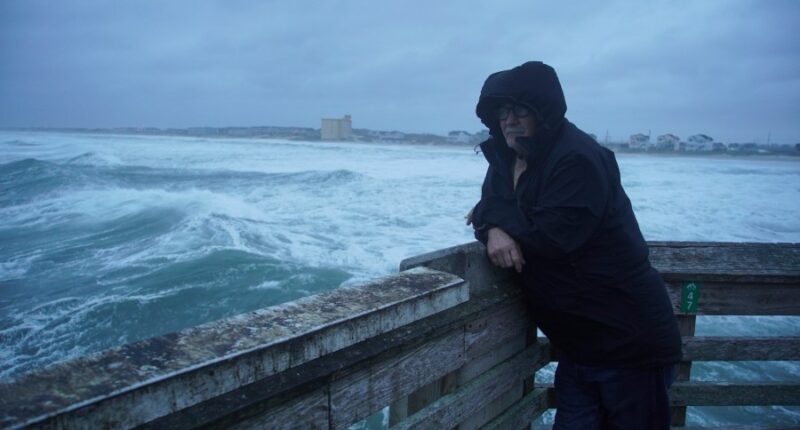Share this @internewscast.com

RODANTHE, N.C. (AP) — Nantucket and Martha’s Vineyard faced strong winds and vigorous waves, while the entire coast from the Carolinas to New England dealt with hazardous rip currents as Hurricane Erin moved further into the ocean.
The hurricane was predicted to potentially cause coastal flooding along the East Coast into the weekend, although it was also anticipated to slowly lose its power. Early on Friday, the National Hurricane Center in Miami stated that Erin had reduced to a Category 1 hurricane, with maximum sustained winds of 90 mph (150 kph), situated approximately 490 miles (785 kilometers) south-southwest of Halifax, Nova Scotia.
Even though Erin is twice as large as a typical hurricane, it has skillfully navigated through the Atlantic between the East Coast and several islands, minimizing its potential for destruction.
On North Carolina’s Outer Banks, waves breached dunes in the town of Kill Devil Hills on Thursday evening, and water and sand pooled on Highway 12.
Although damage assessments were still underway, the low-lying islands appeared to have dodged widespread trouble.
A tropical storm warning remained for Bermuda, advising residents and visitors to avoid the water through Friday. However, warnings for the coasts of North Carolina and Virginia were lifted.
According to the National Hurricane Center in Miami, areas along the mid-Atlantic and southern New England coast could experience wind gusts at tropical storm strength through early Friday.
The National Weather Service issued coastal flood warnings for places as far north as New York and New Jersey.
In New York City, beaches were closed to swimming on Thursday, but over a dozen surfers took to the waves at Rockaway Beach in Queens. Local resident Scott Klossner remarked that the conditions were ideal for proficient surfers.
“You wait all year round for these kinds of waves. It’s challenging, really hard to stay in one place, because there’s a heavy, heavy, heavy rip,” he said. “But this is what surfers want — a hurricane that comes but doesn’t destroy my house? I’ll take that.”
The Outer Banks — essentially sand dunes sticking out of the ocean a few feet above sea level — are vulnerable to erosion. Storm surges can cut through them, washing tons of sand and debris onto roads and sometimes breaking up pavement and creating new inlets.
The dunes and beach took a beating the last two days, but Dare County Manager Bobby Outten said there have been no new inlets with Erin or significant structural damage to homes or businesses.
“All in all it’s not as bad as it could have been,” Outten said. “Hopefully the worst of it is behind us.”
On Jennette’s Pier in Nags Head, where sustained winds reached 45 mph (72 kph), dozens of onlookers snapped photos of the huge waves crashing into the structure amid driving rain.
“This is nature at her best,” Nags Head resident David Alan Harvey said. “I love this. I love these storms.”
Erin has fluctuated in intensity since forming nearly a week ago but remained unusually large, stretching across more than 600 miles (965 kilometers).
So-called Cape Verde hurricanes like Erin, which originate near those islands off the west coast of Africa, cross thousands of miles of warm ocean and are some of the most dangerous to North America.
___
Seewer reported from Toledo, Ohio. Associated Press journalists Tammy Webber in Fenton, Michigan; Jeffrey Collins in Columbia, South Carolina; Kathy McCormack in Concord, New Hampshire; Julie Walker in New York; and Leah Willingham in Boston contributed.
___ The Associated Press’ climate and environmental coverage receives financial support from multiple private foundations. AP is solely responsible for all content. Find AP’s standards for working with philanthropies, a list of supporters and funded coverage areas at AP.org.

















